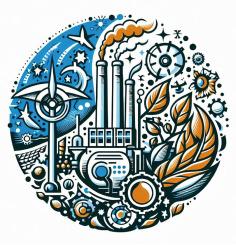Comparative assessment of the parameters of the gas turbine on biohydrogen and biogas
IF 8.3
2区 工程技术
Q1 CHEMISTRY, PHYSICAL
引用次数: 0
Abstract
The most important industry for achieving development objectives and achieving economic independence for the nation is the energy sector. The primary energy source is fossil fuels. Burning conventional fuels has a negative impact on the environment. Alternative fuels are now a promising development in energy. Biogas and biohydrogen have the potential to be used in place of conventional fuels in areas without electricity. There are a number of organic raw materials (plant and animal waste, including cow dung, poultry droppings, corn silage, straw, and husk) that can be used to make an alternative fossil fuel. Building new energy systems that use organic waste to produce heat and electric energy is made possible by the acquisition of biofuels. In this study, the work of the gas turbine power plant (GTPP) on various bums with an assessment of performance indicators and emissions into the environment is considered. To simulate the operation of the gas turbine installation, a mathematical model of the gas turbine engine was created in the AC GRET software complex, and the mathematical model was identified.

生物氢气和沼气燃气轮机参数的比较评价
实现发展目标和实现国家经济独立的最重要产业是能源部门。主要的能源是化石燃料。燃烧传统燃料对环境有负面影响。替代燃料现在是一种很有前途的能源发展。在没有电的地区,沼气和生物氢有可能取代传统燃料。有许多有机原料(植物和动物粪便,包括牛粪、家禽粪便、玉米青贮饲料、稻草和谷壳)可用于制造替代化石燃料。通过获得生物燃料,建立利用有机废物产生热能和电能的新能源系统成为可能。在本研究中,考虑燃气轮机发电厂(GTPP)在各种锅炉上的工作,并对其性能指标和环境排放进行评估。为了模拟燃气轮机装置的运行,在AC GRET软件综合体中建立了燃气轮机发动机的数学模型,并对数学模型进行了辨识。
本文章由计算机程序翻译,如有差异,请以英文原文为准。
求助全文
约1分钟内获得全文
求助全文
来源期刊

International Journal of Hydrogen Energy
工程技术-环境科学
CiteScore
13.50
自引率
25.00%
发文量
3502
审稿时长
60 days
期刊介绍:
The objective of the International Journal of Hydrogen Energy is to facilitate the exchange of new ideas, technological advancements, and research findings in the field of Hydrogen Energy among scientists and engineers worldwide. This journal showcases original research, both analytical and experimental, covering various aspects of Hydrogen Energy. These include production, storage, transmission, utilization, enabling technologies, environmental impact, economic considerations, and global perspectives on hydrogen and its carriers such as NH3, CH4, alcohols, etc.
The utilization aspect encompasses various methods such as thermochemical (combustion), photochemical, electrochemical (fuel cells), and nuclear conversion of hydrogen, hydrogen isotopes, and hydrogen carriers into thermal, mechanical, and electrical energies. The applications of these energies can be found in transportation (including aerospace), industrial, commercial, and residential sectors.
 求助内容:
求助内容: 应助结果提醒方式:
应助结果提醒方式:


